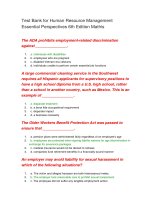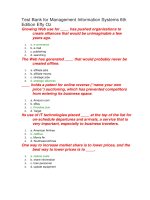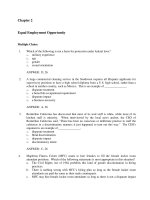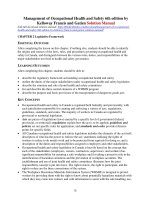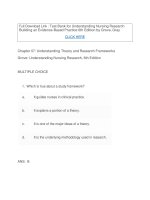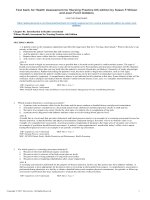Lecture Project management in practice (6th Edition) – Chapter 8: Evaluating and terminating the project
Bạn đang xem bản rút gọn của tài liệu. Xem và tải ngay bản đầy đủ của tài liệu tại đây (545.07 KB, 26 trang )
Project Management in Practice
Sixth Edition
Chapter 8
Evaluating and Closing
the Project
Copyright © 2016 John Wiley & Sons, Inc.
81
Evaluation
•
Appraises the progress and performance of the
project relative to…
a)
b)
•
•
The initial or revised plan
The goals and objectives set for it during the selection
process
Projects should be evaluated at key points in the
project life cycle
Purpose is to improve process of carrying out
future projects
82
Evaluation Criteria
•
•
•
•
Criteria set by senior management
Original criteria for selecting and funding project
Success todate
Business/direct success
–
•
•
Such as the level of commercial success for external
projects and reduced throughput time for internal
projects
Contribution to organization’s goals
Contribution to team member objectives
83
Four Important Dimensions of
Project Success
1.
2.
3.
4.
Efficiency in meeting the budget and
schedule
Customer impact/satisfaction
Business/direct success
Future Potential
84
Items to Consider for Project
Evaluation Report Recommendations
•
•
•
•
•
•
•
•
•
Communication with the client and senior management
Locating opportunities for technological advances
Reduction of indirect costs and direct costs
Improving the projectmanagement process
Identification of risks in the organization’s use of projects
Utilization of the skills resulting from project members’
work on projects
Employment of general management experience gained by
project managers
Improving the organization’s use of projects
Increasing the speed of obtaining results in projects
85
Measurement
•
Measuring performance against planned
budgets and schedules
–
•
Relatively straightforward
Measurement of actual expenditure and
earned values
–
More complicated
86
Project Auditing
•
A special type of evaluation is the formal audit
–
–
•
•
Not a financial audit
Broader in scope and may deal with the whole or any
part of the project
A thorough examination of the management of a
project, its methodology and procedures, its
records, properties, inventories, budgets,
expenditures, progress, and so on
Broader than the traditional management audit
87
The Audit Process
•
•
The timing of the audit depends on the
purpose
An audit can be conducted at three levels:
1.
2.
3.
General: usually constrained by time and cost
and limited to project essentials
Detailed: initiated if the general audit finds
something that needs further investigation
Technical: usually performed by a team with
technical skills
88
Timing and Value of Project Audits
•
Initiation
–
–
•
Feasibility study
–
•
Very useful, especially technical audit
Preliminary plan/schedule budget
–
•
Very useful
Takes place early
Very useful for setting measurement standards
Master schedule
–
–
Less useful
Flexibility of team limited
89
Timing and Value of Project Audits
Continued
•
Evaluation of data by project team
–
–
•
Implementation
–
–
•
Marginally useful
Team defensive
More or less useful
Depends on importance of project methodology to
successful implement
Postproject
–
–
More or less useful
Depends on applicability to future projects
810
Typical Steps in a Project Audit
Familiarize the audit team with the
requirements of the project
1.
–
2.
3.
4.
Including its basis for selection and any
special charges by upper management
Audit the project onsite
Write up the audit report
Distribute the report
811
To Ensuring an Effective Audit
The Audit Team Must…
•
•
•
•
•
•
Have free access to anyone with knowledge of the
project
Make sure the project team is aware of the audit
Avoid judgmental comments
Understand the politics of project team
Confirm all information (wherever possible)
Understand that project team members rarely trust
auditors
812
Form to Audit a Software
Installation Project
Figure 81
813
The Audit Report
•
Introduction
–
•
Current status
–
•
Description of project and its goals
Comparison of work completed and planned
Future project status
–
–
Conclusions regarding project progress
Recommendations for changes for subsequent
projects
814
The Audit Report Continued
•
Critical management issues
–
•
Risk analysis and risk management
–
•
Issues senior management should monitor
Potential for project failure and monetary loss
Final comments
–
Caveats, assumptions, limitations
815
Project Closure
•
Every project is closed
–
–
•
Way it is handled may have an impact on the success of
the project
–
•
•
Quickly or slowly
Referred to as project closure
Will have a major impact on residual attitudes toward the project
In some industries the teams remain relatively intact
In other industries, project closure is similar to the breakup
of a family
816
When to Close a Project
Is the organization is willing to invest the time
and cost required to complete the project
•
Given its current status and expected outcome
Assumes sunk costs are irrelevant
–
–
•
The criteria commonly applied for deciding
whether to close a project fall into two general
categories
1.
2.
The degree to which the project has met its goals
The degree to which the project qualifies against a set
of success factors
817
Four Generic Factors Associated
with Project Failure
1.
2.
A project was not required for this task in the
first place
Insufficient support from senior management
•
3.
Naming the wrong project manager
•
4.
Especially for unanticipated resources
Often a person with excellent technical skills but
weak managerial skills
Poor upfront planning
818
Five Questions to Decide Which
Projects to Continue
1.
2.
3.
4.
5.
Which projects have a legal or strategic
imperative?
Which projects are luxuries?
Which projects are likely to drive future revenue
and growth?
Which projects best match our skill sets and
strengths?
What are the risks to the business if we do not
service the project’s deliverables?
819
811
Types of Project Closure
•
Project Extinction
–
•
Closurebyaddition
–
•
When an inhouse project is successfully and is institutionalized as
a new formal part of the organization
Closurebyintegration
–
•
Project activity suddenly stops because it has been successfully
completed or has a high expectation of failure
The output of the project becomes a standard part of the operating
system of the sponsoring firm or the client
Closurebystarvation
–
Occurs when it is impolitic to close a project but it’s budget can be
squeezed until it is a project in name only
820
The Closure Process
•
Decision should be made by a broad based
committee of senior managers
–
–
•
•
Projects do not take kindly to being shut down
Shutting down an ongoing project is not a
mechanistic process
Closure process should be specified in
project plan
A closure manager should be appointed
821
Project Personnel
•
•
One of the more difficult jobs is the reassignment
of project personnel
In a functional organization, it usually entails a
transfer back the parent department
–
•
When a large project is shut down, team members may
be laid off
In a pure project organization there may be more
projects to which project personnel can be
transferred
–
–
There is no “holding” area for personnel
As a result, layoffs are common
822
A WBS for a Closure Project
Figure 83
823
Main Duties of the Closure Manager
•
•
•
•
•
•
•
•
•
Ensure completion of the work
Notify the client of project completion
Ensure that documentation is complete
Clear all accounts and invoicing
Redistribute personnel, material, equipment
Clear project with legal counsel
Save records that need to be saved
Project any support material
Close project books
824
The Project Final Report
•
Project performance
–
•
Administrative performance
–
•
Identify modifications to help future projects
Project teamwork
–
–
•
Review of how well administrative practices worked
Organizational structure
–
•
What was achieved and reasons for resulting performance
Team members who worked particularly well and very poorly
Confidential part of report
Project management techniques
–
Recommendations for improvements in future projects
825
